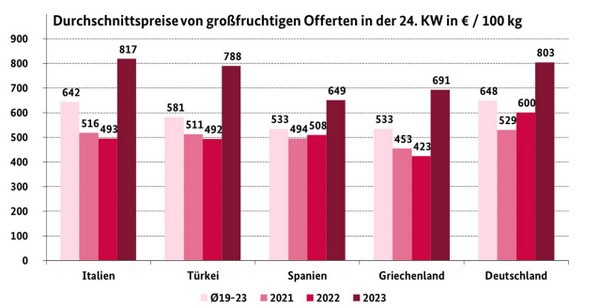The supply of sweet cherries has grown strongly, especially the Italian and Turkish deliveries have intensified massively. Greek unloadings expanded as well, according to BLE. Only Spanish inflows lost some of their significance. Customers were particularly keen to pick up fruit of 28 mm and above; smaller calibers sometimes found it difficult to generate sufficient attention. In terms of quality, there was hardly anything to complain about: Ferrovia and Duroni from Italy, Napoleon from Turkey and Pella from Greece were generally convincing in terms of coloration and taste.

On occasion, the availability of southern European imports at the squares was rather limited, as extensive quantities were tied to the food retail sector. Nevertheless, demand was mostly met without difficulty. Quotations often crumbled somewhat, although demand was not unfriendly. Domestic volumes expanded, but their marketing was mixed: locally, they met with little interest as the trade was firmly in the hands of European competitors. In some cases, however, the offers could be placed quickly, even at prices of up to just under €11 per kg.
Click here for the full market and price report.
Apples
The European supply obviously decreased. From the domestic market, mainly Elstar, Jonagold and Tenroy were available. Italy contributed mainly Granny Smith and Pink Lady to the range. French imports, as well as Dutch and Polish, were only of a supplementary nature. Imports from overseas, on the other hand, increased.
Pears
Chilean and South African imports formed the basis of the product range. Offers from Argentina rounded off the range. European offers played only a minor role. Overall, demand was not particularly strong and was easily met.
Table grapes
Italian lots were now at the top of the range: Black Magic and Victoria were flanked primarily by Supernova. Imports from Egypt followed in terms of importance, with Flame Seedless, Prime Seedless and Early Sweet being the main choices.
Strawberries
Local fruits obviously dominated the scene. Deliveries from the Netherlands, Poland and Belgium supplemented the marketing, Greek offers were only in Berlin. Availability had expanded. Interest could not always keep pace. Concessions were therefore needed if larger stocks were to be avoided.
Peaches and nectarines
Unloading from Spain and Italy was growing, in some cases quite massively. Demand, while not unfriendly, could not keep pace with the extended supply. Quotations fell as a result, sometimes quite sharply.
Apricots
Inflows from Spain, Turkey, Italy and France increased massively. Meanwhile, more secerpare were provided from Turkey, and Matador increasingly disappeared from the market. Interest was not enough to achieve clearance. Concessions were intended to boost trade, but this did not always succeed.
Lemons
Spanish and South African imports formed the basis of the product range. Their presence had expanded. Turkish, Italian and Greek batches, on the other hand, remained a marginal note. Demand was easily satisfied.
Bananas
Provisioning was usually adjusted to interest. The traders thus seldom had cause to modify their previous demands. In isolated cases, accommodation had improved, so slight increases in price could be enforced.
Cauliflower
Domestic batches apparently predominated and were available in some places like a monopoly. In some places, there were also expensive Belgian and inexpensive Polish offerings. In Munich, Italian batches were also available, but due to their poor quality, they were sold rather under notice.
Lettuce
Domestic lettuce supplies predominated. Belgian batches supplemented the event. In iceberg lettuce, German shipments were flanked by Dutch shipments. The presence of Spanish produce, quite unusual at this time of the season, expanded very strongly. Domestic deliveries dominated in the colored lettuce category.
Cucumbers
Domestic, Dutch and Belgian snake cucumbers formed the basis of the supply. Deliveries had expanded. Demand could hardly keep pace with the increased availability. Concessions were therefore needed if major surpluses were to be avoided.
Tomatoes
As in previous weeks, Belgian and Dutch shipments dominated the scene. Their availability had expanded. Interest, on the other hand, remained at the stable level of the 23rd week. Consequently, distributors were often forced to adjust their previous calls downwards.
Sweet peppers
Dutch lots predominated and were available in some places almost like a monopoly. In terms of importance, Turkish products followed Belgian offers. Few domestic products appeared only sporadically.
Asparagus
The season progressed and was already nearing its end. Deliveries were reduced and interest was also noticeably diminished. Some traders had already withdrawn from marketing. Quotations generally knew only one direction: they moved downward.
Source:BLE
